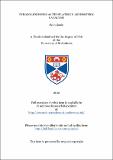Files in this item
Pyrazolidinones as templates in asymmetric catalysis
Item metadata
| dc.contributor.advisor | Smith, Andrew David | |
| dc.contributor.author | Gould, Eoin | |
| dc.coverage.spatial | iii, 219 | en_US |
| dc.date.accessioned | 2013-06-10T10:47:31Z | |
| dc.date.available | 2013-06-10T10:47:31Z | |
| dc.date.issued | 2012 | |
| dc.identifier | uk.bl.ethos.574767 | |
| dc.identifier.uri | https://hdl.handle.net/10023/3646 | |
| dc.description.abstract | This thesis principally focuses on the development of a novel series of asymmetric iminium ion organocatalysts, based on the pyrazolidin-3-one template. Also described is the development of a novel asymmetric Steglich rearrangement with pyrazolyl carbonates. The pyrazolidin-3-one framework has been identified as a potentially effective new scaffold for iminium ion organocatalysis. The development of a synthetic route to racemic pyrazolidinone catalysts is outlined which allows for systematic variation of key substituents. The influence of these groups on reactivity and diastereoselectivity in the Diels-Alder reaction of (E)-cinnamaldehyde and cyclopentadiene is described and an optimised catalyst identified. A method for the resolution of a simple pyrazolidinone precursor was then investigated in order to access an enantioenriched catalyst for asymmetric reaction. Resolution was achieved by amide coupling to a chiral acid, chromatography to separate the subsequent diastereoisomers and acid cleavage. The initial enantioenriched catalyst gave modest enantioselectivity in the Diels-Alder reaction. The diastereoisomeric intermediates in the resolution process were themselves identified as active and enantioselective iminium ion organocatalysts. In general, one diastereoisomer was superior in terms of enantioselectivity, indicating a ‘matching’ of the two catalyst stereocentres. An optimised asymmetric diastereoisomeric catalyst derived from a trifluoromethyl-substituted pyrazolidinone and Cbz-protected proline gave good diastereo- and enantioselectivities in Diels-Alder reactions with a range of aryl aldehydes. Mechanistic investigations with this compound then found that fast ring-opening occurs under catalysis conditions creating a new chiral hydrazide which was catalytically active at catalyst loadings as low as 1 mol%. Also explored was the Steglich rearrangement of structurally related pyrazolyl carbonates. Rearrangement was observed with a range of Lewis base organocatalysts, with N-heterocyclic carbenes (NHCs) generally superior. Chiral NHCs were also effective in an asymmetric reaction, particularly with methyl substituted pyrazolyl carbonates. | en_US |
| dc.language.iso | en | en_US |
| dc.publisher | University of St Andrews | |
| dc.subject.lcc | QD505.G7 | |
| dc.subject.lcsh | Enantioselective catalysis | en_US |
| dc.subject.lcsh | Imines | en_US |
| dc.subject.lcsh | Ions | en_US |
| dc.title | Pyrazolidinones as templates in asymmetric catalysis | en_US |
| dc.type | Thesis | en_US |
| dc.type.qualificationlevel | Doctoral | en_US |
| dc.type.qualificationname | PhD Doctor of Philosophy | en_US |
| dc.publisher.institution | The University of St Andrews | en_US |
This item appears in the following Collection(s)
Items in the St Andrews Research Repository are protected by copyright, with all rights reserved, unless otherwise indicated.

